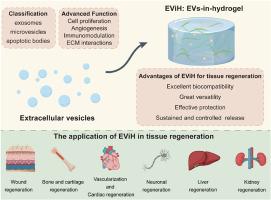水凝胶中的细胞外小泡(EViH)以病理生理学为目标,促进组织修复
IF 18
1区 医学
Q1 ENGINEERING, BIOMEDICAL
引用次数: 0
摘要
再生医学致力于利用生物方法恢复受损组织和器官。利用生物材料靶向调节受损组织的病理生理过程是推动这一领域发展的重要方法。细胞外囊泡-水凝胶(EViH)系统融合了细胞外囊泡(EVs)和水凝胶的优点,使其成为再生医学领域的一种重要生物材料,具有很大的临床应用潜力。本综述阐明了 EViH 系统在组织再生中的发展和优势,强调了 EVs 和水凝胶的相互作用和影响。此外,它还简明扼要地概述了伤口、骨和软骨损伤、心血管疾病、神经损伤以及肝脏和肾脏损伤等各类组织损伤的病理生理特点,强调了 EViH 系统如何针对这些过程解决相关的组织损伤问题。最后,它探讨了进一步推进基于 EViH 的组织再生所面临的挑战和前景,旨在传授对 EViH 的全面理解。其目的是全面概述 EViH 在促进再生医学应用方面的作用,并激励研究人员为再生医学设计创新的组织工程材料。本文章由计算机程序翻译,如有差异,请以英文原文为准。

Extracellular Vesicles-in-Hydrogel (EViH) targeting pathophysiology for tissue repair
Regenerative medicine endeavors to restore damaged tissues and organs utilizing biological approaches. Utilizing biomaterials to target and regulate the pathophysiological processes of injured tissues stands as a crucial method in propelling this field forward. The Extracellular Vesicles-in-Hydrogel (EViH) system amalgamates the advantages of extracellular vesicles (EVs) and hydrogels, rendering it a prominent biomaterial in regenerative medicine with substantial potential for clinical translation. This review elucidates the development and benefits of the EViH system in tissue regeneration, emphasizing the interaction and impact of EVs and hydrogels. Furthermore, it succinctly outlines the pathophysiological characteristics of various types of tissue injuries such as wounds, bone and cartilage injuries, cardiovascular diseases, nerve injuries, as well as liver and kidney injuries, underscoring how EViH systems target these processes to address related tissue damage. Lastly, it explores the challenges and prospects in further advancing EViH-based tissue regeneration, aiming to impart a comprehensive understanding of EViH. The objective is to furnish a thorough overview of EViH in enhancing regenerative medicine applications and to inspire researchers to devise innovative tissue engineering materials for regenerative medicine.
求助全文
通过发布文献求助,成功后即可免费获取论文全文。
去求助
来源期刊

Bioactive Materials
Biochemistry, Genetics and Molecular Biology-Biotechnology
CiteScore
28.00
自引率
6.30%
发文量
436
审稿时长
20 days
期刊介绍:
Bioactive Materials is a peer-reviewed research publication that focuses on advancements in bioactive materials. The journal accepts research papers, reviews, and rapid communications in the field of next-generation biomaterials that interact with cells, tissues, and organs in various living organisms.
The primary goal of Bioactive Materials is to promote the science and engineering of biomaterials that exhibit adaptiveness to the biological environment. These materials are specifically designed to stimulate or direct appropriate cell and tissue responses or regulate interactions with microorganisms.
The journal covers a wide range of bioactive materials, including those that are engineered or designed in terms of their physical form (e.g. particulate, fiber), topology (e.g. porosity, surface roughness), or dimensions (ranging from macro to nano-scales). Contributions are sought from the following categories of bioactive materials:
Bioactive metals and alloys
Bioactive inorganics: ceramics, glasses, and carbon-based materials
Bioactive polymers and gels
Bioactive materials derived from natural sources
Bioactive composites
These materials find applications in human and veterinary medicine, such as implants, tissue engineering scaffolds, cell/drug/gene carriers, as well as imaging and sensing devices.
 求助内容:
求助内容: 应助结果提醒方式:
应助结果提醒方式:


